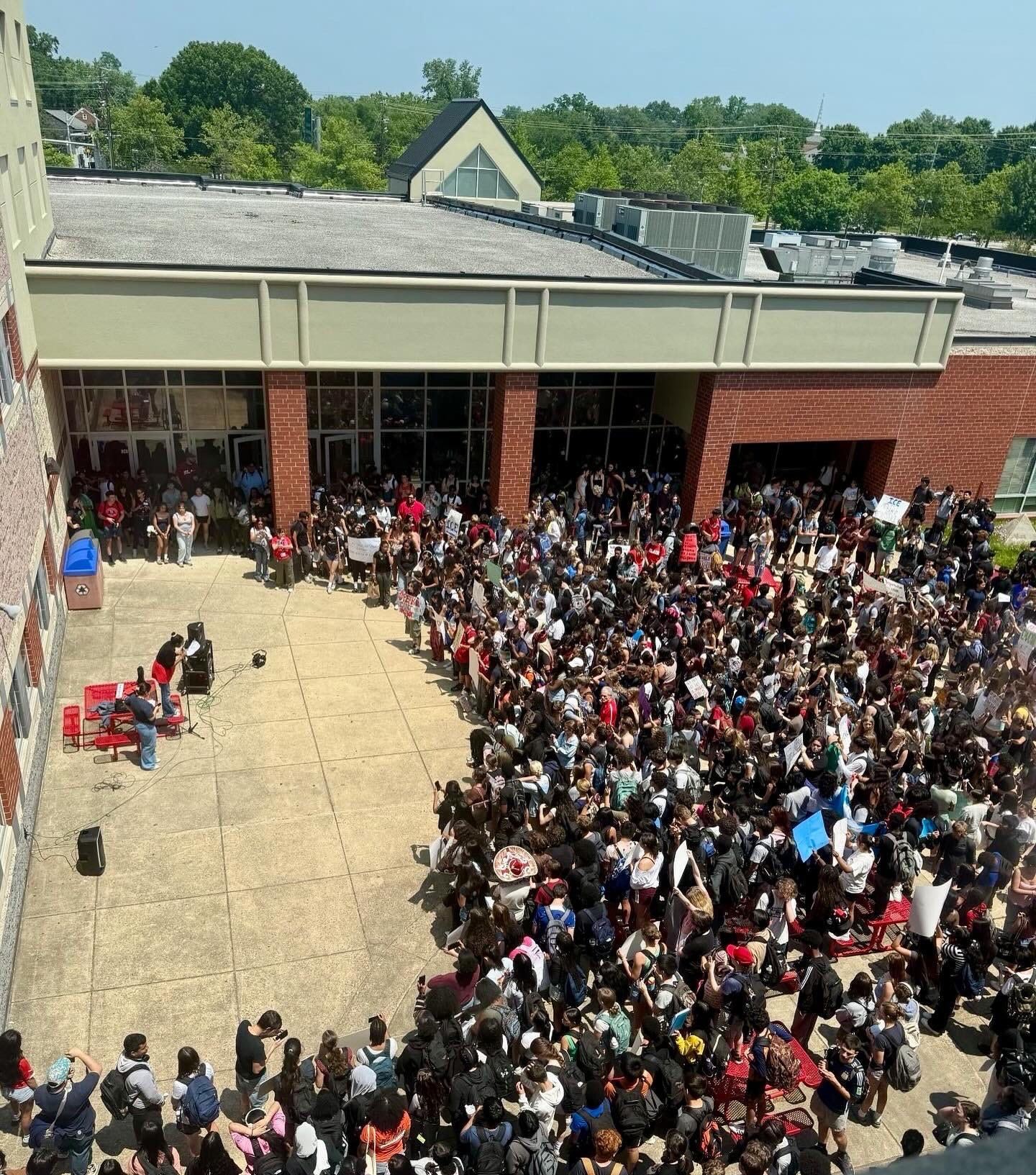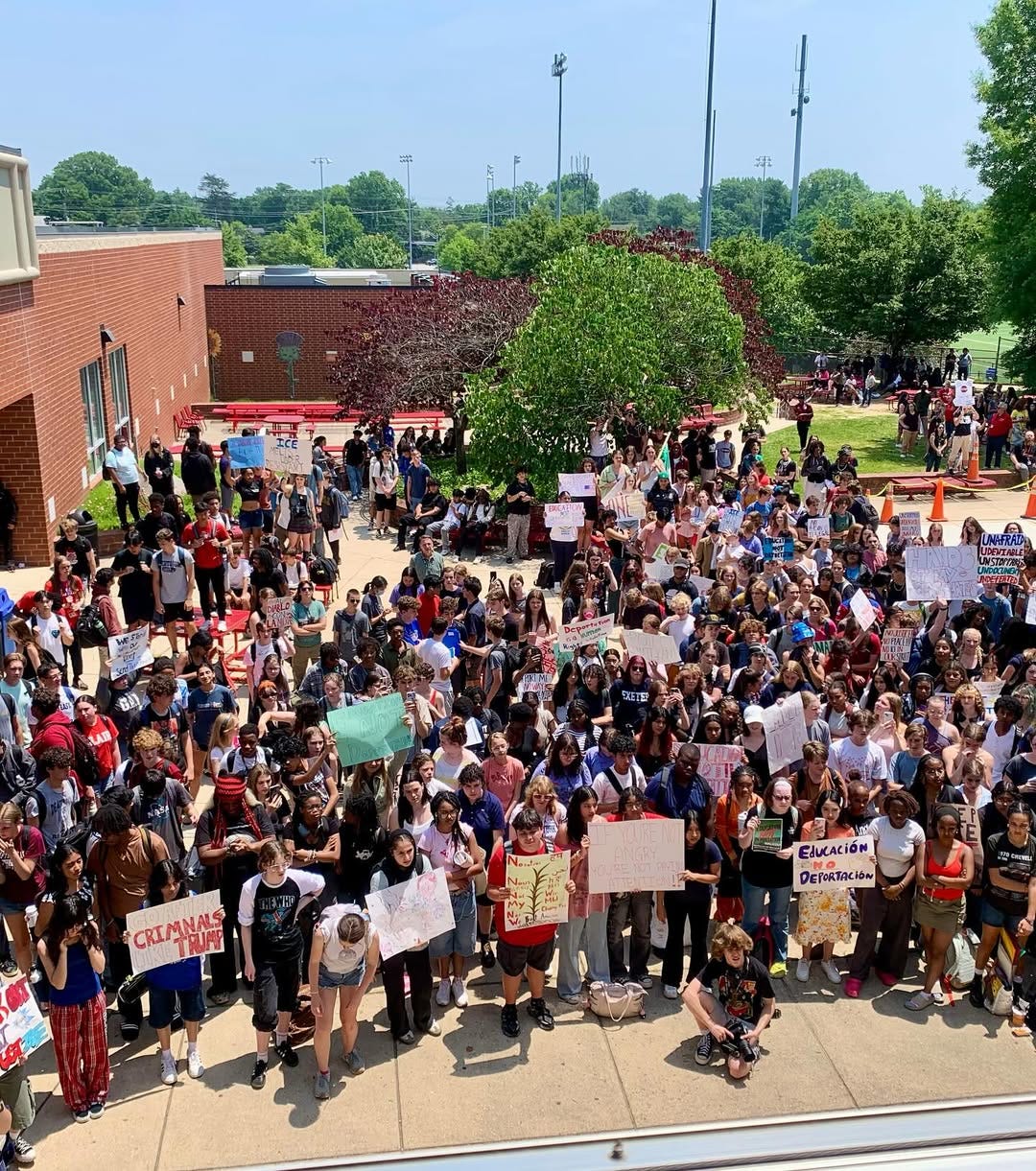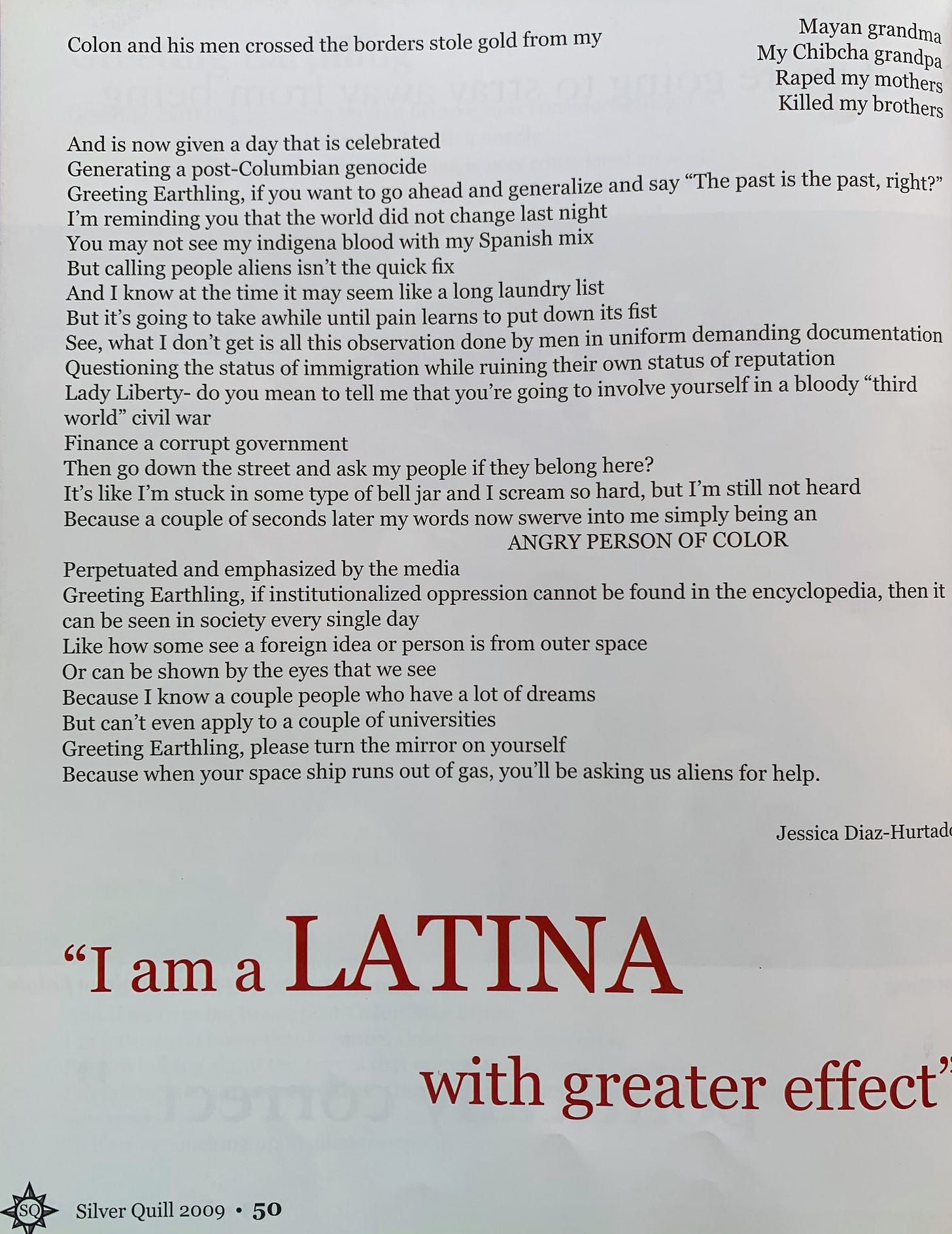Immigration, Schools, and the Blair Student Walk Out
I go by Mr. Lynch in the classroom and I was convinced that at some point a student would take the umbrella handle off the Y in my name and I would be Mr. Lunch. Laughter would erupt. I waited, but it never happened.
Then the “three stooges” started coming into my room before class and goofing around. They had a class next door in an ELD (English Language Development) history course. Their teacher Mr. Gibb, a legendary figure at Blair who retired in 2024 with a streak of mischief and humor, gave them the nickname. Joking at the class door, dropping into my class, teaching me Spanish, and generally adding some life to the day, the “Three Stooges” chuckled as one of them gave me that much-anticipated nickname—Mr. Lunch. Finally!
We would do well to remember the impact that immigrants have on our country and our day-to-day lives. In this case, it was a good laugh.
That same laughter and silliness of the “Three Stooges” that brightened our Blair hallway also helped the Nationals win their first World Series. Be sure to read Hugs, kids’ songs and so much dancing: How the Nationals’ clubhouse became ‘something special.’
This is the Nationals international scouting director on the Latin influence on the team:
“When you have all of those kids, everyone's speaking Spanish and you have the music going, a lot of the Americans sometimes aren't very happy about it,” DiPuglia said. “And they accepted it and part of them became Latinos, too. It was one of the most unbelievable things I've ever seen.”
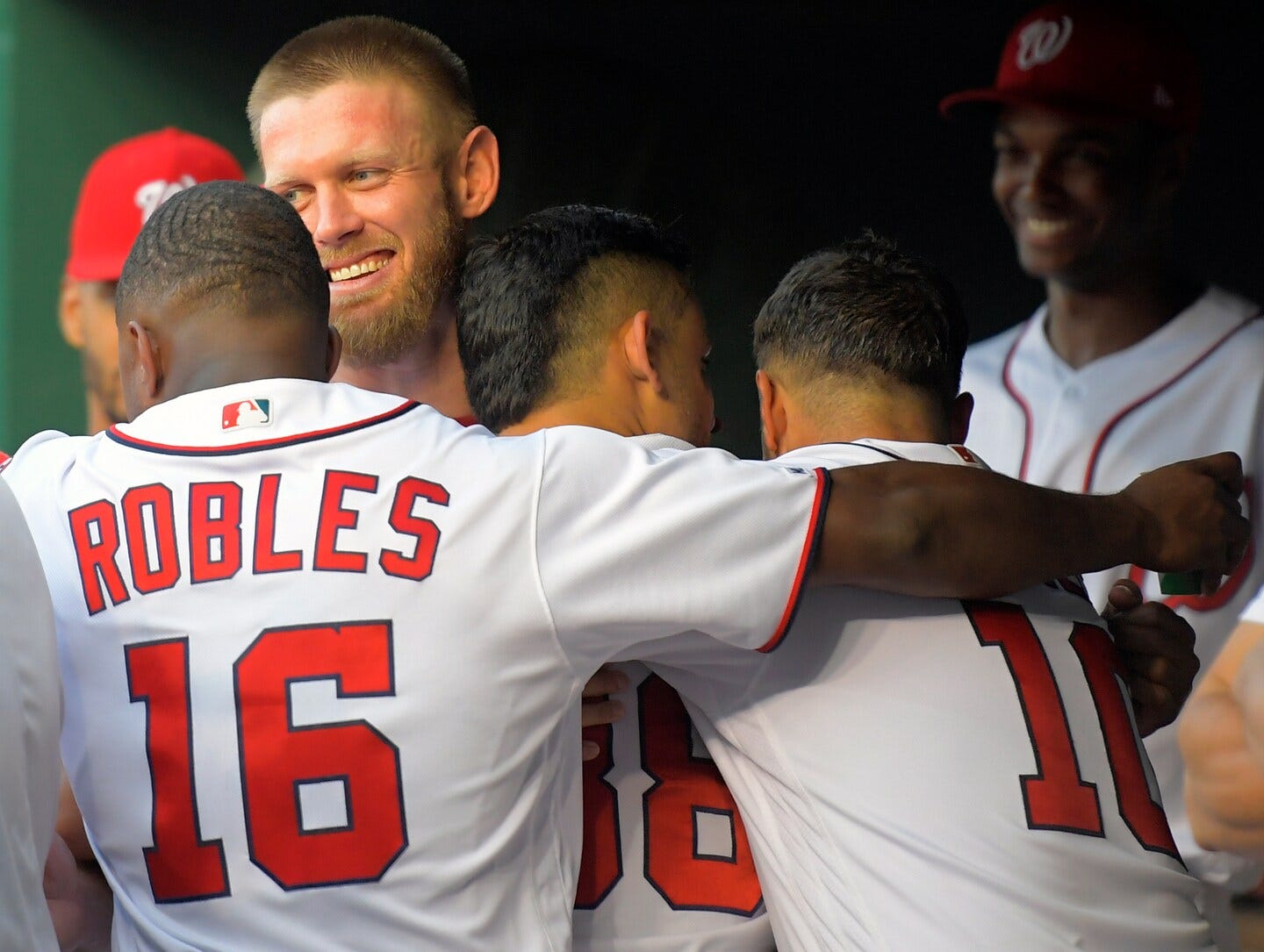
It’s no small feat to get stodgy Washingtonians singing Baby Shark, dancing to reggaeton, and coming together like kids to celebrate something larger than themselves, but a Nationals clubhouse with a Latin influence did just that. Gerardo Parra, the National’s current first base coach and former outfielder, from Venezuela, is credited with this sparking this Nats spirit.
It was like a hamburger without any ketchup or salt, or mayonnaise, or mustard,” DiPuglia said of the clubhouse before Parra arrived. “He put all of the condiments on top of the hamburger.”
That joyful time in Washington D.C. celebrating the World Series seems distant amidst the fear teachers have for their students, students for their families, and friends for one another.
Our young people raised their voices loudly and clearly in response— “No human is illegal,” and “ICE is not welcome here.”
Student leaders in a group called FAIR (Students for Asylum and Immigration Reform) led a schoolwide walkout to reject the cruel deportations.
To take a step back, the lead organizers, mostly juniors, were in 1st grade when Trump rode down that elevator before proclaiming that murderers and rapists were pouring into the country. They would begin their 4th grade year with the images of torch-wielding white supremacists just a couple hours south in Charlottesville. “Good people” as their president referred to them, even as a car drove into a crowd of counter-protesters killing a young woman. This is one example of the tenor of political discourse they have grown up around. They’re not having it.
It brought to mind the 1966 Robert F. Kennedy Day of Affirmation Speech in South Africa in which he addressed college students who protested apartheid.
“Our answer is the world’s hope; it is to rely on youth. The cruelties and the obstacles of this swiftly changing planet will not yield to obsolete dogmas and outworn slogans. It cannot be moved by those who cling to a present which is already dying, who prefer the illusion of security to the excitement and danger which comes with even the most peaceful progress. This world demands the qualities of youth: not a time of life but a state of mind, a temper of the will, a quality of imagination, a predominance of courage over timidity, of the appetite for adventure over the life of ease. It is a revolutionary world that we all live in; and thus, as I have said in Latin America and Asia and in Europe and in my own country, the United States, it is the young people who must take the lead. Thus you, and your young compatriots everywhere have had thrust upon you a greater burden of responsibility than any generation that has ever lived.”
Coincidently we had just covered this speech in an AP Language and Composition class where the question lingered, are kids using their voice today? The students of FAIR and their friends at Blair responded.
I was grateful to hear students reflect after the walkout:
“We always hear that we’ll be the ones to fix so many things, and we’ll take on that responsibility but at the same time it’s frustrating that we’re dealing with this.”
“I’ve never felt so connected with my community here at Blair.”
“It’s hard to put into words and summarize all that I’m feeling about yesterday’s walkout, but I know it was something special.”
“I was so glad to see the whole school come together, and see my friends support each other, and also to see people I sort of knew before but didn’t know they cared, to see them care meant a lot.”
“I stood next to a friend whose parent escaped the crackdown on protests at Tiananmen Square, so it was crazy that now they’re demonstrating against this.”
“I had never participated in a demonstration before but I’m glad I did and was happy to be around my friends to show what we stand for.”
“It really hit me when I was in the gym, and I looked up at the TV, and there we were on national news, and I realized we can make a difference.”
The teachers and staff at Blair were unaware of just how many kids would show up to the walkout. Then the kids came streaming out of the building by the hundreds it seemed. The students formed initially at the front of the school and then circled to the back. Our administration was accommodating to students’ desires to speak. MCPS security and Montgomery County Police were standing by to ensure student safety.
The first speaker was Kyara Romero Lira. Kyara and another Blair FAIR leader Senaya Asfaw had recently helped pass legislation at the Maryland State House to protect immigrant families from ICE in sensitive places like schools and churches.
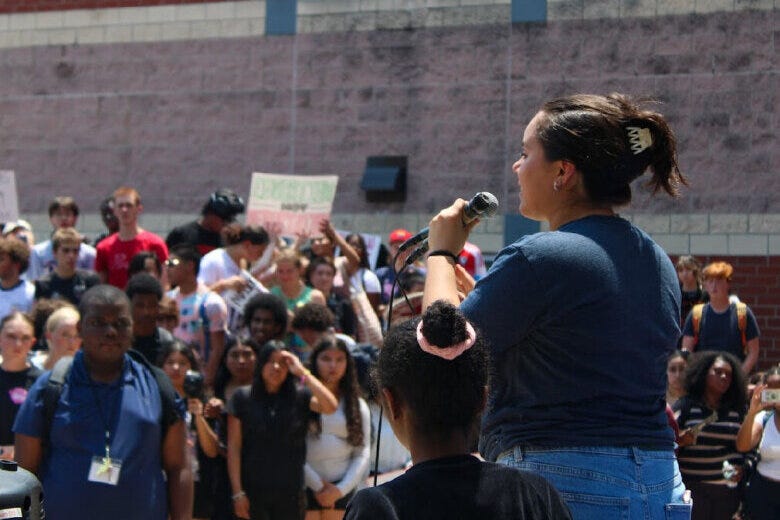
Now the entire Blair community—teachers, custodial staff, administrators, and students—heard from her as she rallied her peers. She said in the Washington Post,
“We want everyone to feel safe, not just within Blair, but outside of Blair, I hope that this sends a clear message that we are fighting for immigrants inside, outside, and everywhere.”
Another FAIR student leader spoke about the need to exercise free speech and speak out. Often this generation is thought of as apathetic, consumed with their screens, but to hear these kids and the reaction they received from their classmates challenge that assumption.
Kristin Mink, a Montgomery County Councilmember, was also invited to speak. An extraordinarily supportive and active local politician, Mink has been instrumental in navigating the current challenges.
Priya, a Blair junior, then recited a poem (found at the bottom of the post) from a Blair literary magazine. Her voice was clear, strong, and held the crowd’s attention, but due to the heat, a student fainted. The poem had to wait, the school nurse was brought out, and the decision was made to close down the walkout.
The contrast was stark. We’ve seen the cruelty all over the news, of masked men taking family members into unmarked vans, and the screams of helpless loved ones. The reality of these episodes is shocking, dystopian, and outrageous. But at this event held by young people to speak out and reject this inhumane immigration policy, when one person was at risk, the entire group paused to ensure their safety.
Blair is a unique place that often feels like the United Nations. Nearly every country in the world is represented here in some way. MCPS has students who speak over 100 languages.

The Blair walkout was a uniquely American coalition and an example of what this country can be—Latinos, Blacks, whites, Asian Americans, Ethiopian Americans, and more, all coming together for justice and one another. They understand the strength of their diversity.
Our community and country thrive on the drive and ingenuity of immigrants. Some Blair students work multiple jobs to help their families and push themselves through school on little sleep after long nights. This would be unthinkable in my own high school experience.
There are many of these examples, but one story has stayed with me. Several years ago I taught in an outdoor classroom, a portable. At the end of the day on a Friday my students filed out, but two people walked in. It looked to be a boy of about 16 or 17 and his mother.
“Do you teach English?” he said.
Even on a Friday afternoon the go-getter students are not asking for help after class. Surprised, I told him I did and was wondering what was coming next.
“My mother,” he began in a slow and cautious cadence, “wants to learn to speak English.”
His mother was standing at the doorway, clearly having plucked up a bit of courage to seek this out. Now they had come to a random outdoor classroom, knocked on the door, and asked for help to speak English. They sought to participate in this society, to further themselves, to reach their American dream.
I took them to the front office and they were given the information on English language classes for adults that a secretary knew about. They were one step closer to that dream they pursued.
If we are to be a country that lives up to our ideals, that becomes worthy of its promise, we must welcome the spirit of those “three stooges,” the World Series Nationals, the students who stand for their community, and the families that seek a better life. They honor the core of who we are, and we must do the same.
“Si se puede”—yes it can be done.
Poem partially read at the Blair Walk Out. Printed in Blair’s 2009 Literary Magazine, Silver Quill, by Jessica Diaz-Hurtado
Thanks for reading. If you want to help, you can donate to this running fund to assist families impacted by ICE deportations and detentions.





